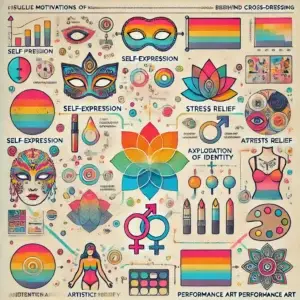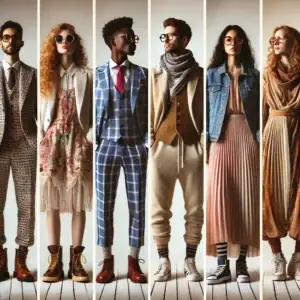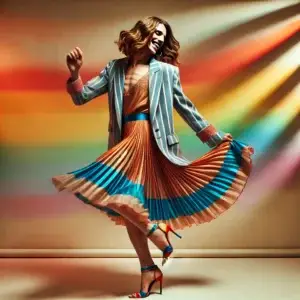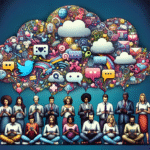
Understanding Cross-Dressing Psychology: Insights and Real-Life Stories
Introduction: Unveiling the Psychology of Cross-Dressing
Cross-dressing is often shrouded in curiosity, misunderstanding, and even controversy. Whether it’s someone privately exploring different clothing styles at home or embracing public expressions that defy traditional norms, cross-dressing raises complex psychological, social, and cultural questions.
At its core, cross-dressing is not a one-size-fits-all experience. It can stem from various motivations, from self-expression to stress relief or even as a facet of deeper identity exploration. Yet, societal misconceptions often lead to stigmatization or simplification of what is, in reality, a nuanced and profoundly personal behavior.
Cross-dressing is a topic deeply rooted in human psychology and warrants careful examination. This article explores the motivations behind cross-dressing, its historical and cultural significance, and its impact on mental health and societal norms. With insights from psychology, real-life case studies, and practical advice, you will walk away with a more compassionate understanding of this multifaceted subject.
Understanding Cross-Dressing: A Psychological Overview
Cross-dressing, at its simplest, involves wearing clothing typically associated with a gender other than one’s own. However, the motivations and meanings behind this practice are as varied as those who engage in it.
Defining Cross-Dressing
Cross-dressing is not inherently linked to gender identity or sexual orientation. While some individuals may use clothing as a means to explore or express their gender identity, others cross-dress for entirely different reasons. These may include artistic expression, comfort, escapism, or cultural traditions.
Psychologically, cross-dressing is often viewed as a behavior that provides emotional or psychological satisfaction. For some, it offers relief from societal expectations; for others, it may simply be a way to connect with a different aspect of their personality.
Motivations Behind Cross-Dressing
The reasons individuals cross-dress can be categorized broadly into three main areas:
- Self-Expression and Identity:
Many use cross-dressing as a way to explore aspects of their identity, especially if they feel constrained by traditional gender roles. - Stress relief and emotional comfort:
For some, cross-dressing is a therapeutic act that helps them manage stress, anxiety, or emotional overwhelm. Psychologists have observed that dressing differently can temporarily escape daily pressures. - Cultural or artistic purposes:
Cross-dressing has a longstanding history in theatre, festivals, and cultural rituals worldwide, where it serves as an artistic or performative element rather than a personal statement.
Is cross-dressing normal?
From a psychological standpoint, cross-dressing is an expected behavior when it does not cause significant distress or impair one’s ability to function. It is important to note that cross-dressing itself is not a disorder. In rare cases, it may be associated with conditions like gender dysphoria or fetishistic behaviours, but these are exceptions rather than the rule.
Cultural and Historical Perspectives

Cross-dressing is far from a modern phenomenon. Throughout history and across cultures, individuals have engaged in cross-dressing for reasons that range from practical necessity to protest, performance, and spiritual expression. Exploring these perspectives not only enriches our understanding of cross-dressing but also dismantles the notion that it is a contemporary or Western-centric practice.
Cross-Dressing in History
- Theatrical Traditions:
In many cultures, cross-dressing has been a staple of theatrical performance. For example:- In ancient Greece and Rome, Women were not permitted to act, so men played female roles by dressing as women.
- Elizabethan England: Similarly, in Shakespeare’s time, male actors took on female roles, contributing to some of the most iconic cross-dressed characters in literature.
- War and Survival:
Cross-dressing has also been a means of survival. Historical accounts document women disguising themselves as men to access opportunities unavailable to them due to their gender:- Joan of Arc wore male armour as protection and practicality in her role as a military leader.
- During the American Civil War, women like Sarah Emma Edmonds cross-dressed to serve as soldiers or spies.
- Ritual and Religion:
Some cultures have incorporated cross-dressing into religious or spiritual rituals.- In Hinduism, depictions of gods such as Shiva and Vishnu occasionally show them in androgynous or blended forms, reflecting divine transcendence of gender.
- Two-Spirit traditions in Native American cultures often included fluid expressions of gender, where clothing played a role in representing their unique identity.
Cross-Dressing Across Cultures
- Japan’s Kabuki Theatre:
The art of onnagata—male actors specializing in female roles—demonstrates how cross-dressing can elevate performance and cultural storytelling. - South Asian Hijra Community:
The hijra, a recognized third gender in South Asia, often uses clothing to express their identities. Their historical and social significance reflects a deep cultural acceptance of gender variance, even if modern attitudes remain mixed. - Western Drag Culture:
Modern drag culture, rooted in LGBTQ+ activism, combines performance, artistry, and political expression. Drag challenges rigid gender norms and often serves as a vehicle for self-expression and advocacy.
How Historical Perceptions Influence Today
While many historical instances of cross-dressing were accepted—or even celebrated—modern societies often impose stricter binaries, leading to stigma or misunderstanding. Recognizing these historical roots can foster greater acceptance and appreciation for the diversity of human expression.
Cross-Dressing and Identity

Cross-dressing is intricately linked to identity, but its relationship with gender identity, sexual orientation, and personal expression is multifaceted and often misunderstood. Understanding these connections can help clarify the motivations and experiences behind cross-dressing while challenging stereotypes and assumptions.
Cross-Dressing and Gender Identity
Cross-dressing is not synonymous with being transgender, although the two are sometimes conflated. Here’s how they differ:
- Cross-Dressing as Expression:
Many individuals who cross-dress identify with the gender they were assigned at birth. For them, cross-dressing may be a way to explore or express a different facet of their personality rather than a statement about their core identity. - For transgender individuals:
For some, cross-dressing may play a role in their journey of exploring or affirming their gender identity. However, this is only one aspect of their experience and should not define their identity.
The Role of Sexual Orientation
Contrary to common misconceptions, cross-dressing is not inherently tied to sexual orientation. People of all sexual orientations engage in cross-dressing. Here are a few key points:
- Independent of Attraction:
Cross-dressing is often about self-expression and comfort rather than who someone is attracted to. - Misconceptions:
The association between cross-dressing and fetishistic behaviour is not representative of the majority. This misunderstanding has contributed to unwarranted stigma.
Identity Beyond Gender

For some individuals, cross-dressing has little to do with gender or sexual orientation. Instead, it may be about:
- Artistic Exploration:
Experimenting with clothing as a form of self-expression or art. - Breaking Norms:
A statement against rigid gender roles and societal expectations.
Psychological Insights on Identity and Cross-Dressing
- Maslow’s Hierarchy of Needs
Cross-dressing can be linked to the need for self-actualization—the pursuit of becoming one’s authentic self. For some, wearing clothing of another gender provides a sense of fulfillment and alignment with their inner self. - Identity Fluidity:
Cross-dressing reflects the broader concept of identity as fluid and multifaceted. It challenges the idea that people must fit neatly into pre-defined categories.
The Importance of Acceptance
For individuals who cross-dress, acceptance—both self-acceptance and societal acceptance—plays a crucial role in their mental well-being. Studies show that those who feel supported in their choices tend to experience lower levels of stress and higher levels of happiness.
Psychological Implications of Cross-Dressing

Cross-dressing can have profound psychological effects on individuals, both positive and negative. These outcomes largely depend on the level of self-acceptance, the presence of supportive relationships, and societal attitudes. By understanding these implications, we can appreciate the role cross-dressing plays in personal well-being and mental health.
Positive Psychological Effects
- Self-expression and Authenticity:
- Cross-dressing allows individuals to express facets of themselves that might otherwise remain suppressed. This authenticity often leads to greater self-confidence and personal satisfaction.
- Many report feeling liberated and aligned with their true selves when cross-dressing, leading to improved self-esteem.
- Stress relief and emotional comfort:
- Engaging in cross-dressing can provide a form of escapism, offering a mental break from rigid societal expectations or personal stressors.
- Studies have highlighted how engaging in creative self-expression, including cross-dressing, can reduce anxiety and promote relaxation.
- Exploration and Personal Growth:
- Cross-dressing often encourages individuals to question and redefine societal norms. This process can lead to personal growth and a deeper understanding of one’s identity.
Challenges and Risks
- Social stigma and discrimination:
- Negative societal perceptions of cross-dressing can lead to judgment, ostracism, or discrimination. This is particularly true in conservative environments where gender norms are rigidly enforced.
- Fear of being misunderstood may cause some to hide their behavior, leading to feelings of isolation or shame.
- Internalised Shame:
- Growing up in a society that marginalizes cross-dressing can result in internalized shame or guilt. This can create a mental conflict between a person’s desires and their self-image.
- Such conflicts may manifest as anxiety, depression, or other mental health challenges if left unaddressed.
- Mislabeling and Pathologisation:
- Historically, cross-dressing has been misunderstood and even pathologized in psychology, leading to stigma. While modern psychology recognizes it as a non-pathological behavior in most cases, outdated views persist in some circles.
Mental Health Perspectives on Cross-Dressing
Psychological research highlights several key aspects of cross-dressing as it pertains to mental health:
- Not a Disorder:
- Cross-dressing, in itself, is not considered a mental health disorder. The American Psychiatric Association’s DSM-5 includes transvestic disorder only when cross-dressing causes significant distress or impairment in daily functioning.
- Gender Dysphoria and Cross-Dressing:
- While distinct from cross-dressing, some individuals with gender dysphoria may cross-dress as part of their exploration of gender identity. It is essential to distinguish between the two to avoid over-generalisation.
- The Importance of Supportive Networks
- The research underscores that individuals who feel supported by family and friends experience better mental health outcomes, regardless of whether they cross-dress for personal or identity-related reasons.
Psychological Tools for Coping and Thriving
- Therapeutic Approaches:
- Therapy can be beneficial for those struggling with internalised shame or societal judgment. Cognitive-behavioural therapy (CBT) is particularly effective for challenging negative thought patterns.
- Building Resilience:
- Self-affirmation and mindfulness can help individuals manage societal pressures and maintain emotional equilibrium.
- Education and advocacy:
- Raising awareness and educating others about the realities of cross-dressing can foster acceptance and help individuals thrive in their chosen expression.
Case Studies: Real-Life Experiences of Cross-Dressing

Real-life stories offer a human lens through which we can understand the diverse motivations, challenges, and triumphs of cross-dressers. These case studies highlight the psychological aspects discussed earlier and bring to life the nuanced nature of cross-dressing.
Case Study 1: James’s Journey to Self-Expression
Background:
A 34-year-old software engineer, James had always felt drawn to women’s clothing. Growing up in a conservative household, he suppressed these feelings, fearing judgement.
Experience:
In his mid-20s, James began privately exploring cross-dressing, initially as a way to manage stress after long workdays. “It felt like slipping into another version of myself,” he explained. Over time, he realised it wasn’t just about clothing but about embracing a softer, more carefree side of his personality.
Challenges:
James struggled with guilt and self-doubt, questioning whether his behavior was “normal.” Fear of discovery added to his anxiety, limiting his ability to share this part of his life.
Resolution:
Through therapy, James learned to accept his cross-dressing as a healthy form of self-expression. He later confided in close friends, who offered support and reassurance. “Talking about it lifted a huge weight off my shoulders,” James shared. Today, he views cross-dressing as an integral part of his identity and uses it as a tool for personal empowerment.
Case Study 2: Priya’s Fight Against Cultural Norms
Background:
Priya, a 27-year-old teacher in India, grew up in a traditional family where gender roles were strictly defined. She began cross-dressing in her teens, borrowing her brother’s clothes to feel more comfortable and authentic.
Experience:
For Priya, cross-dressing wasn’t about rebellion—it was about self-identity. “I never felt like I fit the mold of what a woman should look or act like,” she explained. Wearing masculine clothing helped her feel at ease with herself.
Challenges:
Priya faced intense criticism from her community when her cross-dressing habits became known. “People accused me of disrespecting my culture,” she recounted. The backlash took a toll on her mental health, leading to periods of depression.
Resolution:
With the support of an LGBTQ+ advocacy group, Priya found a community that accepted and celebrated her choices. She also began educating her peers about the spectrum of gender expression, transforming her struggle into a platform for awareness.
Case Study 3: Alex’s Performance Art and Cross-Dressing
Background:
Alex, a 40-year-old artist, discovered cross-dressing during college. For Alex, it wasn’t just a personal activity—it was an integral part of their artistic expression.
Experience:
Through performance art, Alex used cross-dressing to challenge societal norms and provoke thought. “When I step on stage, I’m not just wearing clothes; I’m telling a story about freedom, identity, and fluidity,” Alex explained.
Challenges:
Critics often labelled Alex’s work provocative or inappropriate, dismissing their art as “just dressing up.” This feedback sometimes made Alex question their path, though their passion kept them moving forward.
Resolution:
Over time, Alex gained recognition for their work and built a supportive audience. “I’ve learned that authenticity resonates deeply. Cross-dressing is part of who I am as an artist, and embracing it has allowed me to create my best work,” they said.
Lessons from These Stories
- Self-acceptance is key.
Each individual found peace by accepting their cross-dressing as a legitimate and positive part of their identity. - Support Networks Matter:
Whether through friends, therapists, or advocacy groups, having a supportive environment proved critical in overcoming challenges. - Breaking Stigma Through Awareness:
Sharing personal stories and educating others helped these individuals reduce stigma and foster understanding.
Societal Perceptions and Addressing Misconceptions
Cultural norms, historical influences, and ongoing conversations about gender and identity shape society’s attitudes toward cross-dressing. These perceptions can often lead to misunderstandings, stereotypes, and stigmatization, which impact the lives of those who cross-dress. By examining these misconceptions, we can work toward greater awareness and acceptance.
Common Misconceptions About Cross-Dressing
- “Cross-Dressing is Always About Gender Dysphoria”
- Reality: While some individuals who cross-dress may also experience gender dysphoria, the majority do not. Many cross-dress as a form of self-expression unrelated to their gender identity.
- “It’s Just a Fetish.”
- Reality: While cross-dressing may have a sexual component for some, it is far more often a multifaceted behaviour involving emotional, psychological, and cultural dimensions.
- “Cross-Dressers Are Always LGBTQ+”
- Reality: Cross-dressers can identify as heterosexual, homosexual, bisexual, or any orientation. Cross-dressing is not inherently linked to sexual preference.
- “Cross-dressing is deceptive.”
- Reality: This stereotype is rooted in media portrayals where cross-dressing is used as a plot device for deceit or disguise. Most cross-dressers are simply expressing their authentic selves.
- “It’s a phase.”
- Reality: For some, cross-dressing may be exploratory or situational. For others, it is a consistent and profoundly personal aspect of their lives.
How Societal Norms Influence Cross-Dressing
- The Role of Gender Binaries
Many societies impose strict expectations about how men and women should behave and appear. Cross-dressing challenges these binaries, making it a target for criticism in more rigid cultures. - Media Representation:
Media often reinforces stereotypes about cross-dressing, portraying it as comedic, deviant, or scandalous. Positive and nuanced depictions are rare, though representation has improved in recent years. - Cultural Acceptance:
Some cultures are more accepting of gender-fluid expressions, while others enforce strict dress codes tied to religious or traditional values. This variance shapes how cross-dressers are treated globally.
Addressing Misconceptions and Reducing Stigma
- Education and Awareness:
Public education campaigns and inclusive media representation can help normalise cross-dressing by presenting it as a valid form of self-expression. - Encouraging Open Conversations:
Creating safe spaces for dialogue allows individuals to share their experiences, challenge biases, and foster understanding. - Advocacy and Allyship:
Advocacy groups play a crucial role in protecting the rights of cross-dressers and promoting acceptance. Allies can amplify these efforts by challenging discriminatory behaviours and supporting cross-dressing individuals. - Reframing the narrative:
Viewing cross-dressing as a form of creativity and personal freedom rather than deviance or rebellion can shift public perception.
Changing Trends in Perceptions
In recent years, societal attitudes have progressed.
- The rise of drag culture, gender-fluid fashion, and non-binary identities has normalized discussions around cross-dressing.
- Social media platforms provide visibility for cross-dressers to share their stories and build supportive communities.
- Younger generations, especially Gen Z, show greater openness to challenging traditional gender norms.
While challenges remain, these trends suggest a move toward broader acceptance and understanding.
Supporting Someone Who Cross-Dresses

Whether you are a friend, family member, or partner of someone who cross-dresses, providing support can make a significant difference in their well-being. Cross-dressing is deeply personal, and a supportive environment fosters self-acceptance and reduces the associated stigma. Here are practical ways to offer understanding and encouragement.
1. Educate Yourself
Take the time to learn about crossdressing and its many facets. Understanding that cross-dressing is not a one-size-fits-all experience helps eliminate assumptions and fosters more meaningful conversations.
- Read credible sources: Seek out books, articles, or videos from experts in gender studies and psychology.
- Avoid stereotypes: Challenge your preconceptions and avoid media portrayals that might oversimplify or mock cross-dressing.
2. Communicate Openly
Encourage honest and judgement-free conversations. Let the person know they can talk to you without fear of criticism or misunderstanding.
- Ask thoughtful questions: Show curiosity without prying. For example, “How does cross-dressing make you feel?” or “What can I do to support you?”
- Be an active listener. Validate their feelings and experiences rather than trying to offer solutions or judgments.
3. Respect Boundaries
Recognise that cross-dressing may be a sensitive subject for some. If someone isn’t ready to share certain aspects of their experience, respect their privacy.
- Keep their confidence. If they’ve shared their cross-dressing with you, honour their trust by not discussing it with others without permission.
- Allow them to set the pace. Let them determine how much they want to share and when.
4. Challenge Stigma and Stereotypes
Be an advocate by challenging misconceptions about cross-dressing in your social circles.
- Speak up: When you hear disparaging remarks or misinformation, gently correct them.
- Promote positive representation: Share content that depicts cross-dressing respectfully and authentically.
5. Offer Practical Support
Clothing and Shopping: If they are comfortable, accompany them shopping for clothing or accessories they enjoy. This can be an affirming experience.
Encourage safe spaces: Help them find communities, events, or groups where they can express themselves freely without judgement.
6. Support Mental and Emotional Well-Being
Cross-dressers may experience internal or external pressures that affect their mental health. Be mindful of their emotional needs.
- Encourage professional support. If they’re struggling with shame, anxiety, or self-acceptance, suggest speaking with a therapist experienced in gender issues.
- Celebrate their journey: acknowledge their courage in embracing a part of themselves, especially in the face of societal judgment.
7. Be Patient
Everyone’s journey with self-expression is unique. Be patient as they navigate their feelings and experiences, and avoid pressuring them to conform to your understanding timeline.
Supporting Partners of Cross-Dressers
For romantic partners, learning about and supporting cross-dressing within the relationship can strengthen trust and connection.
- Acknowledge your feelings: It’s normal to experience confusion or uncertainty. Seek resources or counselling to process your emotions constructively.
- Discuss boundaries: Discuss what cross-dressing means to your partner and how it fits into your relationship dynamic.
- Focus on the person, not the clothing. Remember that your partner is the same person you care about, regardless of attire.
FAQs: Addressing Common Concerns About Cross-Dressing
Here are clear and concise answers to some of the most frequently asked questions about cross-dressing, designed to address misconceptions and provide a more profound understanding.
1. Is cross-dressing the same as being transgender?
No, cross-dressing and being transgender are distinct.
- Cross-dressing: involves wearing clothing associated with a different gender, often as a form of self-expression, comfort, or exploration.
- Being transgender refers to identifying with a gender different from the one assigned at birth, which encompasses a more profound and more consistent experience of gender identity.
2. Is cross-dressing related to sexual orientation?
No, cross-dressing is not inherently tied to sexual orientation. People of all orientations—heterosexual, homosexual, bisexual, or asexual—may cross-dress. It is primarily about self-expression and is independent of who someone is attracted to.
3. Does cross-dressing mean someone is unhappy with their gender?
Not necessarily.
- Many cross-dressers are comfortable with their assigned gender but enjoy exploring different aspects of their personality or breaking societal norms through clothing.
- For others, it might reflect a deeper connection to another gender, though this is not universally true.
4. Is cross-dressing considered a mental health disorder?
No, cross-dressing itself is not a disorder.
- It is a normal behavior unless it causes significant personal distress or negatively impacts daily functioning, in which case professional support may be helpful.
5. Why do people cross-dress?
People cross-dress for various reasons, including:
- Self-expression or exploration.
- Artistic or cultural purposes.
- Stress relief and emotional comfort.
- Challenging traditional gender norms.
6. Is cross-dressing just a phase?
Not always.
- For some, it may be exploratory or situational.
- For many others, it is a consistent and meaningful part of their identity or self-expression.
7. How should I respond if someone tells me they cross-dress?
- Be supportive and non-judgemental.
- Listen to their experiences and feelings without making assumptions.
- Respect their privacy and trust.
8. Can cross-dressing improve mental health?
Yes, for many individuals, cross-dressing can:
- Promote self-expression and reduce stress.
- Help them feel more authentic and aligned with their identity.
- Foster personal growth and emotional well-being.
9. Is cross-dressing harmful in relationships?
Not inherently. When approached with open communication and mutual respect, cross-dressing can lead to deeper trust and understanding. Problems may arise only if one partner feels unprepared to navigate this aspect of their relationship.
10. How can society better support cross-dressers?
- Challenge stereotypes and normalize conversations about cross-dressing.
- Provide safe spaces and inclusive policies.
- Promote accurate and respectful representations in media.
- Educate others on the diversity of human expression.
We hope to provide clarity and reassurance by addressing these common questions and empowering readers to explore their sexuality with confidence and understanding of cross-dressing psychology.






















Under “Motivations Behind Cross-Dressing,” how can you have missed: “it’s a turn on?” Some do it for that and only that.
My sister, who’s 13 years older, would let me in her room when she was getting ready for a date. She knew I desired trying on her clothes and allowed me to try on her bra, panty, and pantyhose often while I was in her room. I also was mesmerized by watching her apply her makeup, so she started to put lipstick on me and foundation. I was only 5 or 6 but I enjoyed the feminine experience. My sister knew how much I enjoyed girly things and eventually dug out her old clothes for me to wear. My parents knew nothing of my feminine side, but my sister chose to foster my enthusiasm for the feminine. One time when my parents were visiting relatives, my sister encouraged me to dress up in her old clothes and gave me the spa treatment with painting my nails and doing a full makeup routine. Then she chose her old dress, panty. training bra, and white tights that she helped dress me. She even had an old pair of black Mary Jane shoes she had me wear. After dressing me up we went for a drive in the park and she told her friends that I was a niece visiting. After that 1st time of wearing those nylon panty’s and microfiber tights, I regularly visited my sister’s room to attain my feminine fix, u until she left for college, when I lost my feminine refuge. My sister did provide some dresses/skirts, panties, bras for me to sneak and hide, and even bought me a makeup set that I eventually used up all the makeup. She also warned me that unless I could make myself up to pass as a girl, to confine my feminine fix to home when my parents were gone. I never felt strange dressing up as a female, and actually enjoyed the preparation time. I crossdress most of the time 60 years later, and have 2 closets for all my wardrobe and shoes. I’ve got good enough to pass as a female at night, and my girlfriend and I have ventured out together when I crossdressed, and even ate at Panera once , as my heart was racing that I’d be exposed. I now have naturally curly hair I grew to mid back length and my hairdresser has styled in several patterns which has helped tremendously in giving me the confidence to go out with my girlfriend more often and heightened my feminine experience.
Thank you for sharing your personal journey so openly. Your story highlights how cross-dressing can begin as a deeply personal exploration of identity, comfort, and expression, and how these early experiences can shape one’s sense of self over time. Many individuals find strength and authenticity in embracing their feminine or masculine side, and it’s encouraging to hear how you’ve developed confidence in your expression over the years.
Cross-dressing, as psychology reminds us, is not only about clothing—it often connects to feelings of self-acceptance, creativity, and even emotional relief. Your reflections on family influences, secrecy, and eventual confidence to step out in public resonate with the experiences of many others in the community.
At Psyforu, we appreciate such contributions because they remind readers that gender expression is diverse and personal. Every journey is unique, and voices like yours add real meaning to discussions about understanding cross-dressing psychology.